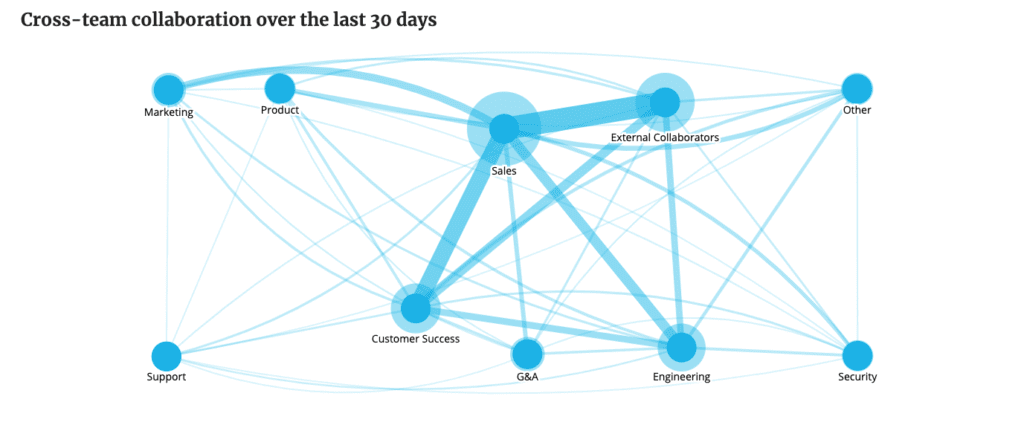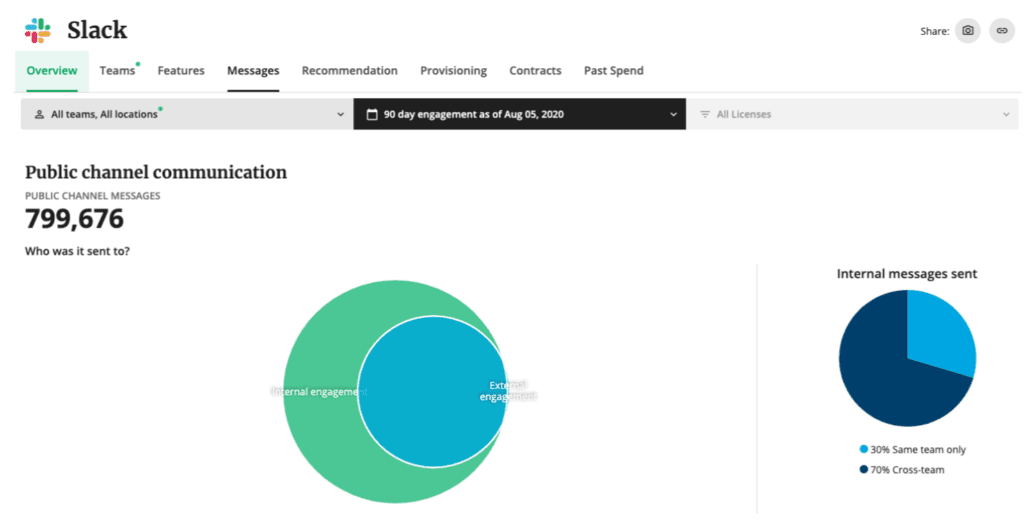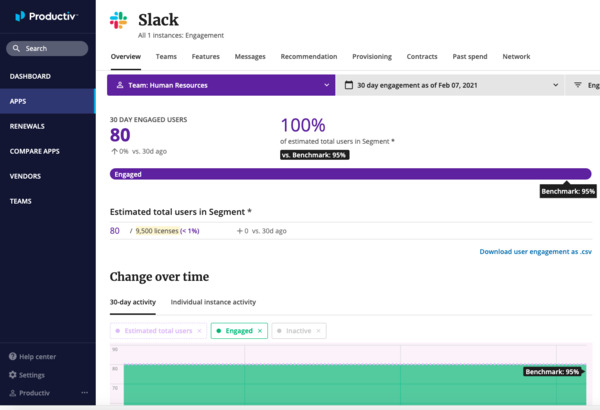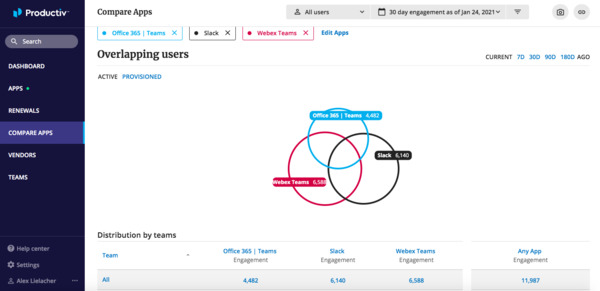
Collaboration Software ROI: What’s the Value of Your Messaging Applications?
Collaboration software allows your employees to easily share, access, and modify information so they can be more productive. In today’s highly-remote work environment, it enables employees to connect to one another and get work done quickly and effectively.
Yet, just because you have a collaboration suite in place, how do you know what kind of ROI you’re getting from it?
In this article, we’ll explore what collaboration software is, how you determine the ROI of collaboration suites, and how Productiv can help.
What Is a Collaboration Software Solution?
Collaboration software such as Slack, Microsoft Teams, and Google Chat are platforms that help coworkers distribute, access, and edit files and documents within an organization. These platforms are SaaS applications, sharing information through the cloud.
The benefit of these applications is that users can be anywhere and use them at any time. As a result, SaaS collaboration suites can have a big impact on driving productivity.
How Can You Tell If You’re Getting Good Collaboration Software ROI?
However, just because you’ve implemented collaboration software doesn’t mean that you’re getting great ROI on it.
That raises an important question: what is collaboration software ROI, and how do you measure it?
ROI actually goes beyond how much money you’re saving, or how the collaboration suite boosts the bottom line. Collaboration software ROI also looks at these things:
- Are employees using your collaboration software?
- Are employees using the collaboration software’s premium features?
- Are employees engaging with the collaboration software?
- Are you meeting your collaboration software adoption goals?
- Are your employees using collaboration apps aside from the one you’ve implemented?
Productiv: Measuring Collaboration Software ROI
Productiv helps you measure collaboration software ROI with real-time analytics about how employees are using your collaboration suite.
In the following sections, we’ll look at one of the most popular collaboration suites on the market – Slack – and how Productiv measures its ROI.
Slack and User Engagement
Before we discuss the kind of ROI you can get from Slack, and how Productiv helps you measure it, let’s take a moment to talk about what it means to engage with Slack.
App engagement answers these questions:
- How often are employees using a given application?
- How many employees use this application?
In the next sections, we’ll explore what app engagement means in the context of Slack.
Measuring Slack Collaboration ROI
There are three ways to look at Slack collaboration:
- Open collaboration
- Cross-team collaboration
- External collaboration
Open Collaboration in Slack
In the context of Slack, “open collaboration” means that employees work together freely – there’s no strict hierarchy. One of the best examples of open collaboration is a company-wide brainstorming session.
How do you measure how much open collaboration is taking place within Slack? Look at how often employees are using public channels (channels that are open to anyone within the company except for external parties).
A 2020 Productiv study analyzed 4 million Slack messages from 40,000 users, and researchers discovered that Slack users are more than twice as likely to public channels (74%) than users of other enterprise collaboration suites (34%) such as Microsoft Teams.
Cross-Team Collaboration in Slack

Cross-team collaboration in Slack means that teams work together. For example, members of the HR team could use Slack to talk to their peers in Accounting. Cross-team collaboration stands in contrast with inter-team collaboration, in which members of the same team use Slack to communicate with one another.
Productiv data shows that approximately 80% of Slack users send cross-team messages within the collaboration suite.

Furthermore, Productiv’s research shows that Slack enables greater cross-team collaboration than other messaging platforms: over 90% of companies using Slack have over 70% of users engaging in cross-team collaboration.
External Collaboration in Slack
While internal collaboration is critical to accomplishing organizational goals, it’s also vital that employees work with people outside of the organization (such as customers or suppliers). With collaboration suites like Slack, users can alert external partners about upcoming issues and make sure everyone is on the same proverbial page.
According to Productiv data, Slack drives external collaboration as well as internal collaboration. For every ten internal messages Slack users send, they send an average of 4.8 external messages (approximately one external message for every two messages). Moreover, the number of external messages sent through Slack is growing – between August 2019 and August 2020, 43% of the businesses we’ve analyzed have increased the volume of external messages sent through Slack.
Productiv and Software Adoption Goals
Do you have a goal of reaching 100% adoption of your collaboration suite? Is that even a realistic goal?
Productiv can tell you; we track collaboration software adoption rates across industries. You can see adoption rates across companies as well as across teams.

For example, you could see if your HR team is using Slack as much as other HR departments in your industry. If the adoption rate is lower at your firm, you can work on a strategy to boost it so that you see the best possible collaboration software ROI.
Are Your Employees Using Other Collaboration Apps?
There are times when you implement software, and employees decide that for whatever reason, there are other apps that better meet their needs. They use those apps, as opposed to the software in which you’ve invested. This situation is especially frustrating when the vendor assured you that this app would achieve high ROI and would drive productivity.

For example, you might have invested in Slack, yet employees are using something else to communicate.
That’s where Productiv comes in.
Not only does it track logins for apps, but it also shows you whether employees are using other apps similar to the one for which you’ve paid. With that information, you can create a strategy to shift people to using Slack.
Productiv: Your Collaboration Software ROI Solution
If you’ve invested in a collaboration suite, you want to make sure you get the highest ROI possible. Productiv’s real-time analytics give you insight into how employees are engaging with your collaboration software. Click here to learn why 4 Million Slack Messages Can’t be Wrong.